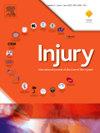青少年生活方式因素与成年早期高能量创伤之间的关系:纵向研究
IF 2.2
3区 医学
Q3 CRITICAL CARE MEDICINE
Injury-International Journal of the Care of the Injured
Pub Date : 2024-10-30
DOI:10.1016/j.injury.2024.112008
引用次数: 0
摘要
导言:目前还缺乏将生活方式因素作为高能量创伤风险因素的纵向研究。本研究旨在调查在芬兰平均27年的随访期间,14至18岁青少年的健康相关行为、超重、慢性疾病、家庭社会经济地位(SES)和成年后教育水平对高能量创伤风险的影响。材料和方法基线数据是1981年至1997年期间每两年收集一次的调查(青少年健康和生活方式调查),并与从医疗保健登记册中检索到的直至2018年的高能量创伤结果数据单独链接。我们采用逻辑回归模型分析了青少年时期暴露变量(经常体育锻炼、超重、吸烟、每月酗酒、慢性病、家庭经济和社会地位、成年后教育水平)与高能量创伤总体风险之间的关联。结果 在随访期间,共有 876 人(1.8%)受到过高能量创伤。总体而言,男性比女性更容易被诊断为高能量创伤(2.8% 对 1.0%)。随访结果显示,吸烟(aOR 1.49,CI 1.40-1.58)、每月酗酒(aOR 1.49,CI 1.39-1.59)、青少年时期患有慢性疾病(aOR 1.22,CI 1.12-1.34)或成年后仅获得较低教育水平(aOR 1.39,CI 1.30-1.48)的人发生高能量创伤的几率更高。结论在平均 27 年的随访中,吸烟、每月酗酒、青少年时期自我报告的慢性病以及成年后教育水平低会增加高能量创伤的风险。青少年时期经常运动和超重并不能预测高能量创伤的发生。干预计划还应关注这些风险因素的长期后果。本文章由计算机程序翻译,如有差异,请以英文原文为准。
Association between adolescent lifestyle factors and high-energy traumas in early adulthood: A longitudinal study
Introduction
Longitudinal studies investigating lifestyle factors as risk factors for high-energy traumas from adolescence to adulthood are lacking. The aim of this study was to investigate the influence of 14 to 18-year old adolescent health-related behaviours, overweight, chronic disease, family socioeconomic status (SES), and adulthood education level on the risk of high-energy traumas during the average 27-year follow-up in Finland.
Materials and methods
The baseline data were surveys gathered biennially from 1981 to 1997 (the Adolescent Health and Lifestyle Survey) and individually linked with outcome data on high-energy traumas retrieved from the Care Register for Health Care until the year 2018. A logistic regression model was used to analyse the associations between the exposure variables in adolescence (frequent physical activity, overweight, smoking, monthly drunkenness, chronic disease, family SES, adulthood education level) and the overall risk for high-energy traumas. Adjusted odds ratios (aOR) with 95 % confidence intervals (CIs) were computed.
Results
A total of 876 persons (1.8 %) had a high-energy trauma during the follow-up. High-energy trauma diagnoses overall were more common among males than among females (2.8 % vs 1.0 %). Follow-up showed that those who smoked (aOR 1.49, CI 1.40–1.58), were drunk monthly (aOR 1.49, CI 1.39–1.59), had a chronic disease (aOR 1.22, CI 1.12–1.34) in adolescence or had attained only low education level in adulthood (aOR 1.39, CI 1.30–1.48) had higher odds for high-energy traumas. Frequent physical activity or overweight in adolescence were not related to the higher odds for high-energy traumas.
Conclusion
Smoking, monthly drunkenness, self-reported chronic diseases in adolescence, and low educational level in adulthood increased the risk of high-energy traumas during the mean follow-up of 27-years. Frequent physical activity and overweight in adolescence did not predict the occurrence of high-energy traumas. Intervention programs should also focus on the long-term consequences of these risk factors.
求助全文
通过发布文献求助,成功后即可免费获取论文全文。
去求助
来源期刊
CiteScore
4.00
自引率
8.00%
发文量
699
审稿时长
96 days
期刊介绍:
Injury was founded in 1969 and is an international journal dealing with all aspects of trauma care and accident surgery. Our primary aim is to facilitate the exchange of ideas, techniques and information among all members of the trauma team.

 求助内容:
求助内容: 应助结果提醒方式:
应助结果提醒方式:


